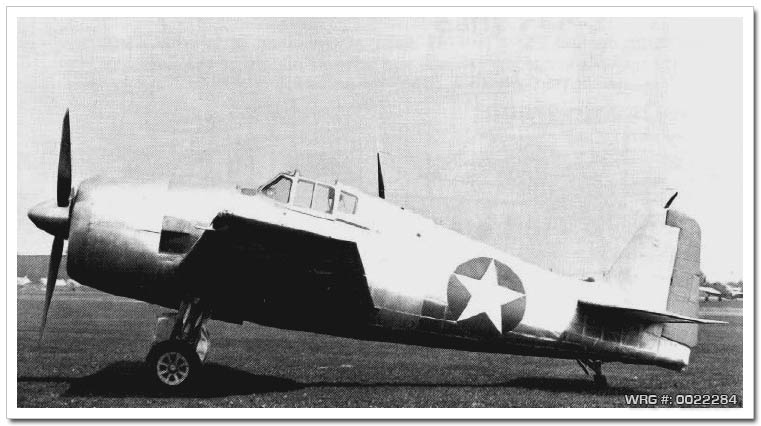U.S. NAVAL AVIATION RESOURCE CENTER > FIGHTERS > HELLCAT > PREVIOUS PAGE
Variants
XF6F-1
First prototype, powered by a two-stage 1,600 hp (1,500 kW) Wright R-2600-10 Cyclone 14 radial piston engine.

The unpainted Grumman XF6F-1 Hellcat fighter in 1942, prior to it's first flight.
[Source: U.S. Navy]
The first XF6F-1 prototype revised and fitted with a turbocharged Wright R-2600-16 Cyclone radial piston engine. R-2600 replaced by turbo-charged R-2800-21.
XF6F-3
Second prototype fitted with a two-stage supercharged 2,000 hp (1,500 kW) Pratt & Whitney R-2800-10 Double Wasp radial piston engine.
XF6F-4
One F6F-3 fitted with a two-speed turbocharged 2,100 hp (1,567 kW) Pratt & Whitney R-2800-27 Double Wasp radial piston engine.
XF6F-6
Two F6F-5s that were fitted with the 2,100 hp (1,566 kW) Pratt & Whitney R-2800-18W radial piston engine, and four-bladed propellers.
Series production
F6F-3 (British designations Gannet Mk. I then Hellcat Mk. I)
Single-seat fighter, fighter-bomber aircraft, powered by a 2,000 hp (1,500 kW) Pratt & Whitney R-2800-10 Double Wasp radial piston engine.
F6F-3E
Night fighter version, equipped with an AN/APS-4 radar in a fairing on the starboard outer wing.
F6F-3N
Another night fighter version, equipped with a newer AN/APS-6 radar in a fairing on the starboard outer wing.
F6F-5 Hellcat (British Hellcat Mk. II)
Improved version, with a redesigned engine cowling, a new windscreen structure with an integral bulletproof windscreen, new ailerons and strengthened tail surfaces; powered by a 2,200 hp (1,640 kW) Pratt & Whitney R-2800-10W (-W denotes Water Injection) radial piston engine.
F6F-5K Hellcat
A number of F6F-5s and F6F-5Ns were converted into radio-controlled target drones.

F6F-3K target drone.
[Source: U.S. Navy]
Night fighter version, fitted with an AN/APS-6 radar. Some were armed with two 20 mm (0.79 in) AN/M2 cannon in the inner wing bays and four 0.50 in (12.7 mm) M2 Browning machine guns in the outer.

A Grumman F6F-5N Hellcat night fighter with AN/APS-6 radar and 2 x 20mm M2 cannon assigned to the NAS Jacksonville, FL, in 1943/44.
[Source: U.S. Navy]
Small numbers of F6F-5s were converted into photo-reconnaissance aircraft, with the camera equipment being fitted in the rear fuselage.
Hellcat FR Mk II
This designation was given to British Hellcats fitted with camera equipment.
FV-1
Proposed designation for Hellcats to be built by Canadian Vickers; cancelled before any built.
Source:
Wikipedia
U.S. NAVAL AVIATION RESOURCE CENTER > FIGHTERS > HELLCAT > PREVIOUS PAGE
